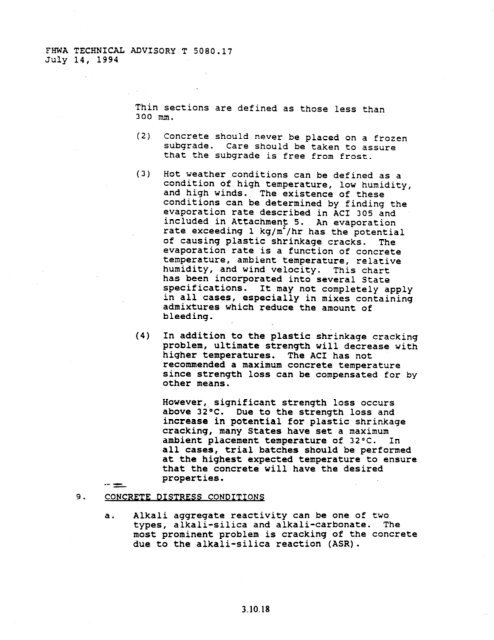chapter 3 rigid pavement - DOT On-Line Publications - Department ...
chapter 3 rigid pavement - DOT On-Line Publications - Department ...
chapter 3 rigid pavement - DOT On-Line Publications - Department ...
Create successful ePaper yourself
Turn your PDF publications into a flip-book with our unique Google optimized e-Paper software.
FHWA TECHNICAL ADVISORY T 5080.17<br />
July 14, 1994<br />
Thin sections are defined as those less than<br />
300 mm.<br />
(2) Concrete should never be placed on a frozen<br />
subgrade. Care should be taken to assure<br />
that the subqrade is free from frost.<br />
(3) Hot weather conditions can be defined as a<br />
condition of high temperature, low humidity,<br />
and high winds. The existence of these<br />
conditions can be determined by finding the<br />
evaporation rate described in AC1 305 and<br />
included in Attachment 5. An evaporation<br />
rate exceeding 1 kg/m'/hr has the potential<br />
of causing plastic shrinkage cracks. The<br />
evaporation rate is a function of concrete<br />
temperature, ambient temperature, relative<br />
humidity, and wind velocity. This chart<br />
has been incorporated into several State<br />
specifications. It may not completely apply<br />
in all cases, especially in mixes containing<br />
admixtures which reduce the amount of<br />
bleeding.<br />
(4) In addition to the plastic shrinkage cracking<br />
problem, ultimate strength will decrease with<br />
higher temperatures. The AC1 has not<br />
recommended a maximum concrete temperature<br />
since strength loss can be compensated for by<br />
other means.<br />
-- 1<br />
However, significant strength loss occurs<br />
above 32'OC. Due to the strength loss and<br />
increase in potential for plastic shrinkage<br />
cracking, many States have set a maximum<br />
ambient placement temperature of 32OC. In<br />
all cases, trial batches should be performed<br />
at the highest expected temperature to ensure<br />
that the concrete will have the desired<br />
properties.<br />
9. CONCRRTE DISTRESS CONDITIONS<br />
a. Alkali aggregate reactivity can be one of two<br />
types, alkali-silica and alkali-carbonate. The<br />
most prominent problem is cracking of the concrete<br />
due to the alkali-silica reaction (ASR).<br />
3.10.18
















